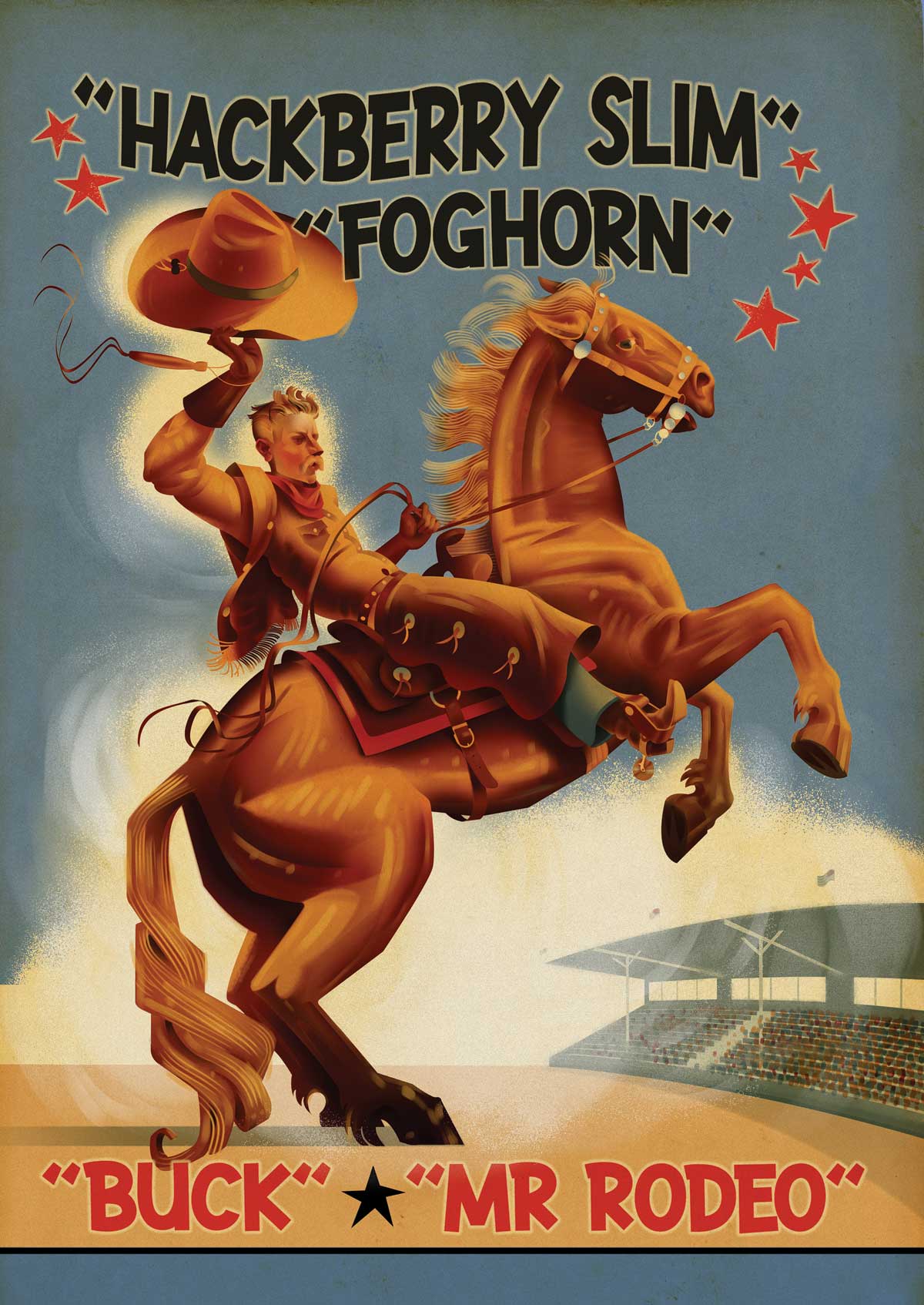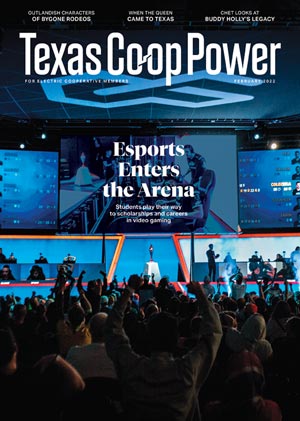Rodeo cowboy Hackberry Slim Johnson came clean in 1956 when he described the 1906 train-jumping accident near Dalhart that cost him half a leg. “I’ve told so many damned lies about losing that leg,” he told an interviewer. But soon after this brief walk on the straight and narrow path of truth, Johnson reverted to his usual yarn about losing the appendage in a “wreck with a wild horse.”
Even though lies might be too harsh a term for the tall tales whipped up by early rodeo cowboys, Johnson was simply following the Texas tradition of stretching the blanket. Even when characters like him, Buck Steiner, Milt Hinkle and Foghorn Clancy told the truth, the stories still sounded like whoppers.
In its beginnings in the late 19th century, mirroring the recently shuttered American frontier, rodeo presented a vast stage for self-invention. “For decades, rodeo was busy defining itself,” says W.K. Stratton, author of Chasing the Rodeo and other books. “The sport was based on the Mexican charreada tradition, which subsequently inspired ‘cowboy contests’ on ranches and in small cattle towns in the West. The advent of Wild West shows and their showbiz elements influenced rodeo as well.
“There was no national sanctioning organization, no set rulebook, so rodeos varied from town to town. People expected to be entertained, and cantankerous old-timers were always a big draw. While elements of showbiz remain, today rodeo is made up of sanctioned athletic contests with standardized events and judging.”
But in its wild and woolly days of old, characters ran the show.
Mr. Rodeo
Milt Hinkle, aka Mr. Rodeo, first glimpsed daylight in 1881 on the patch of Texas Panhandle that became the town of Bovina, which grew from a camp that was part of the XIT Ranch. In 1904, he claimed, Hinkle became the second man to accomplish the act of bulldogging, first performed by the Black cowboy Bill Pickett and known today as steer wrestling. In another boast, Hinkle bragged that he was the first to apply the term “rodeo” to a roundup event.
In 1919 a Saturday Evening Post correspondent wrote about having seen Hinkle suffer a hip injury at a rodeo in Bovina. Three months later, having escaped from the hospital, Hinkle was spotted in Cheyenne, Wyoming, by the same reporter, who described him as “a howling, squawking maniac,” hobbling on crutches as he got ready to bulldog.
The Laredo Times credited Hinkle with the world record for bulldogging from an automobile traveling at 68 mph in 1931. That same year, he agreed to stand in for an “aerial bulldogger” in Nuevo Laredo during the annual Washington’s Birthday Celebration. As Mr. Rodeo prepared to leap onto the running bull, however, el toro turned and charged the aircraft, wrecking it. The border paper reported that Hinkle was not seriously injured.
Decades later, however, Hinkle repeatedly told scribes that he landed successfully on the bull, breaking its neck, and that he himself suffered a crippling hip displacement. Mr. Rodeo had become a promoter, and before his death at 91, he relived the wild old days, lugging his scrapbooks around to reporters and writing for True West and Frontier Times Magazine.
Foghorn
One year younger than Hinkle, famed rodeo announcer Frederick Melton “Foghorn” Clancy tried his hand at bronc riding in an 1898 cowboy tournament in San Angelo. The contest was won by the great Samuel Thomas “Booger Red” Privett, the Erath County native whose legend says he was never thrown, no matter how “outlaw” a horse he drew. And while Foghorn didn’t fare so well in the saddle, the experience opened another career door.
Clancy was working as a hand on the Hittson Ranch in Palo Pinto County when the Spanish-American War broke out. He quit to join the Army but was turned down for being underweight, so he began selling newspapers in the health resort town of Mineral Wells, bellowing headlines to drive sales. Local press observed that he “sounded like a foghorn at sea,” which provided a nickname and a second job as town crier. “I would ride horseback through the little resort,” he wrote in his 1952 autobiography, My 50 Years in Rodeo, “singing out about the attractions at the summer opera house or pavilion.”
Clancy’s stentorian reputation had preceded him in San Angelo, and after his unceremonious buck-off, the folks hosting the ropin’ and ridin’ contest offered him a job as announcer. This was a time before public address systems, but Foghorn lived up to his name, announcing rodeos from one-horse Western towns to Madison Square Garden.
Shortly after he died in 1957, the Hereford Brand reported on a quest by Fort Worth’s Pioneer Days celebration, held at the historic stockyards, to find the loudest Texan. Clancy would have been a shoo-in, and organizers recalled how, in “the old days of the rodeo, the mighty voice of the late Foghorn Clancy rattled the windows.”
Buck
Born in Bastrop in 1899, T.C. “Buck” Steiner lived to see two centuries turn. But long before he died in 2001, the crusty cowpoke had packed several lifetimes into one.
He started early, leaving grade school to pursue the cowboy life. After driving cattle through the streets of Austin, he left home at age 12 to perform in rodeos and Wild West shows, sharing bills with the likes of Annie Oakley and Tom Mix. Steiner demonstrated proficiency at roping, wrestling and riding spirited stock, but he developed a specialty of riding bulls facing backward. As he recalled in endless press features, riding backward was far more lucrative than riding frontward.
Around age 16 he worked for a time at the San Antonio Stockyards. Then at some point, according to the biography of Buck in the Handbook of Texas, a law enforcement career was cut short when he shot at a carload of politicians while working traffic management during a parade. While trailing cattle from Mexico to San Antonio, Steiner reportedly downed a few drinks with Pancho Villa. Later, it’s said, he bent elbows with Al Capone.
Back home in Austin, where a German immigrant ancestor had owned the town’s first harness and saddlery shop, Steiner bought and sold land, operated his own touring rodeos, rented his stock to other rodeos, and opened Capitol Saddlery in 1930. News reports say that he had as many as 96 saddle makers working for him and supplied Montgomery Ward and Sears, Roebuck and Company. In a 1950s rodeo tour of Cuba with Gene Autry, Autry and Steiner got caught up amid Fidel Castro’s revolution. An emergency call to Sen. Lyndon B. Johnson saved their bacon.
The Steiners have been called the royal family of rodeo. Son Tommy Steiner ran the rodeo business until closing it in 1984, and grandson Bobby Steiner won the bull riding world championship in 1973. Buck’s great-grandson, Sid Steiner, won the steer wrestling world championship in 2002.
Hackberry Slim
Toward the end of his long life, Hugh “Hackberry Slim” Johnson II carried his scrapbooks around to newspaper offices in towns where he’d rodeoed in days gone by. Time and again the “only one-legged bronc buster, bulldogger, steer rider and calf roper” in rodeo told the story of his first prosthetic leg, made from a hackberry tree. He talked about working on the XIT and rodeoing with Hoot Gibson and Will Rogers, about the time he drove a bull through a Georgetown furniture store and about winning all-around cowboy in Harlingen in 1933.
He often talked about bison. Hackberry bought his first bison, named Chihuahua, in 1923 and was still producing his “buffalo rodeos” in his 80s. “When I die, I want to go in style,” he often said. “With my boots on. Dancing, maybe, or maybe while riding a buffalo.”
In 1979, shortly after appearing in the Willie Nelson film Honeysuckle Rose, the 91-year-old white-whiskered cowboy danced to Nelson’s band playing Milk Cow Blues, then sat back down and slipped into the sunset.


